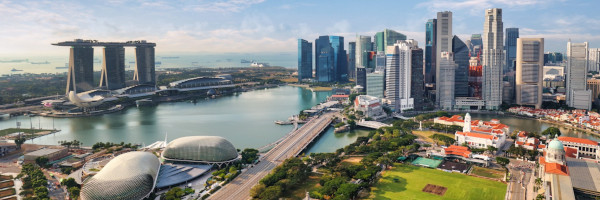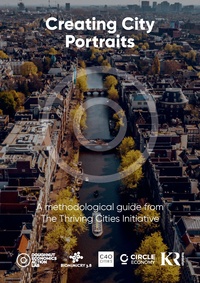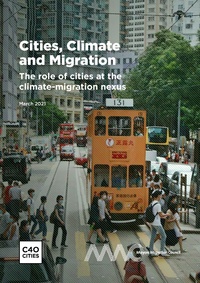What is a Smart City: Difference between revisions
No edit summary |
No edit summary |
||
| (5 intermediate revisions by the same user not shown) | |||
| Line 3: | Line 3: | ||
|poc=Wilfred Pinfold | |poc=Wilfred Pinfold | ||
|authors=Wilfred Pinfold | |authors=Wilfred Pinfold | ||
|blueprint= | |blueprint=Introduction | ||
|chapter= | |chapter=1002 | ||
|sectors= | |sectors=Introduction | ||
|summary=A smart city is a | |summary=A smart city is a municipality that uses information and communication technologies (ICT) to improve the quality of life for its citizens by making the city more efficient, livable, and sustainable. This can be achieved through the use of a variety of technologies, such as sensors, IoT devices, and advanced analytics, to monitor and manage the city's assets and resources, including transportation, utilities, and public services. Smart cities also often have a strong focus on sustainability and use technology to reduce their environmental impact, such as by implementing energy-efficient buildings and transportation systems. | ||
}} | }} | ||
==Quality of Life== | ==Quality of Life==__NOTOC__ | ||
Doughnut economics is an economic model that aims to balance social and environmental sustainability | There are a number of ways to measure the quality of life of a citizen. Some common factors that are often used to measure quality of life include: | ||
#'''Health''': access to quality healthcare and overall physical and mental well-being | |||
#'''[[Education]]''': access to educational opportunities and achievement levels | |||
#'''Income''': financial stability and ability to meet basic needs | |||
#'''Housing''': availability of affordable and suitable housing | |||
#'''[[Transportation]]''': access to reliable and affordable transportation options | |||
#'''Safety''': feeling safe in one's community | |||
#'''Social connections''': having strong relationships with friends and family | |||
#'''Environmental quality''': access to clean air, water, and green spaces | |||
#'''Leisure time''': having access to recreational activities and time to pursue one's interests | |||
Doughnut economics is an economic model developed by economist Kate Raworth that aims to balance social and environmental sustainability within a framework of economic growth. The model is represented by a doughnut-shaped diagram with a hole in the center, which represents the social and environmental boundaries within which humanity can thrive. | |||
In the context of cities, doughnut economics can be used to measure quality of life by helping cities to identify the social and environmental factors that contribute to the well-being of their citizens. For example, a city might use doughnut economics to identify the minimum levels of access to clean water, healthcare, education, and other essential services that are needed to ensure a high quality of life for its citizens. The city could then use this information to set targets and implement policies to improve access to these services. | |||
In addition to looking at social and environmental factors, doughnut economics also emphasizes the importance of economic growth and the role that it can play in improving quality of life. By supporting the growth of local businesses and promoting economic development, cities can create jobs and improve the economic well-being of their citizens. | |||
Overall, doughnut economics provides a holistic framework for understanding and measuring quality of life in cities, and can be used to help cities identify the actions that are needed to improve the well-being of their citizens. | |||
According to doughnut economics, quality of life can be understood by considering how well a city is meeting the needs of its citizens and whether it is operating within the boundaries of what is sustainable for the planet. This approach takes into account a wide range of factors that contribute to quality of life, including access to basic needs such as food, shelter, and healthcare; opportunities for education, employment, and personal development; and a healthy environment. | According to doughnut economics, quality of life can be understood by considering how well a city is meeting the needs of its citizens and whether it is operating within the boundaries of what is sustainable for the planet. This approach takes into account a wide range of factors that contribute to quality of life, including access to basic needs such as food, shelter, and healthcare; opportunities for education, employment, and personal development; and a healthy environment. | ||
| Line 28: | Line 44: | ||
==Data Collection Technology== | ==Data Collection Technology== | ||
Some examples of how smart cities might use technology include: | Some examples of how smart cities might use technology include: | ||
#'''Smart traffic management: Using sensors and analytics to optimize traffic flow and reduce congestion. | #'''Smart traffic management''': Using sensors and analytics to optimize traffic flow and reduce congestion. | ||
#'''Smart energy systems: Using renewable energy sources and efficient energy management systems to reduce energy consumption and costs. | #'''Smart energy systems''': Using renewable energy sources and efficient energy management systems to reduce energy consumption and costs. | ||
#'''Smart waste management: Using sensors and analytics to optimize the collection and disposal of waste. | #'''Smart waste management''': Using sensors and analytics to optimize the collection and disposal of waste. | ||
#'''Smart public safety: Using surveillance and analytics to improve public safety and respond to emergencies. | #'''Smart public safety''': Using surveillance and analytics to improve public safety and respond to emergencies. | ||
#'''Smart health care: Using telemedicine and other digital technologies to improve access to health care services. | #'''Smart health care''': Using telemedicine and other digital technologies to improve access to health care services. | ||
#'''There are many other potential applications of technology in smart cities, and the specific technologies and approaches used will vary depending on the needs and goals of the city. | #'''There are many other potential applications of technology in smart cities, and the specific technologies and approaches used will vary depending on the needs and goals of the city. | ||
==Futureproofing a City== | ==Futureproofing a City== | ||
Latest revision as of 00:53, January 3, 2023
| Introduction | |
|---|---|

| |
| Sectors | Introduction |
| Contact | Wilfred Pinfold |
| Topics | |
- Authors
A smart city is a municipality that uses information and communication technologies (ICT) to improve the quality of life for its citizens by making the city more efficient, livable, and sustainable. This can be achieved through the use of a variety of technologies, such as sensors, IoT devices, and advanced analytics, to monitor and manage the city's assets and resources, including transportation, utilities, and public services. Smart cities also often have a strong focus on sustainability and use technology to reduce their environmental impact, such as by implementing energy-efficient buildings and transportation systems.
Quality of Life
There are a number of ways to measure the quality of life of a citizen. Some common factors that are often used to measure quality of life include:
- Health: access to quality healthcare and overall physical and mental well-being
- Education: access to educational opportunities and achievement levels
- Income: financial stability and ability to meet basic needs
- Housing: availability of affordable and suitable housing
- Transportation: access to reliable and affordable transportation options
- Safety: feeling safe in one's community
- Social connections: having strong relationships with friends and family
- Environmental quality: access to clean air, water, and green spaces
- Leisure time: having access to recreational activities and time to pursue one's interests
Doughnut economics is an economic model developed by economist Kate Raworth that aims to balance social and environmental sustainability within a framework of economic growth. The model is represented by a doughnut-shaped diagram with a hole in the center, which represents the social and environmental boundaries within which humanity can thrive.
In the context of cities, doughnut economics can be used to measure quality of life by helping cities to identify the social and environmental factors that contribute to the well-being of their citizens. For example, a city might use doughnut economics to identify the minimum levels of access to clean water, healthcare, education, and other essential services that are needed to ensure a high quality of life for its citizens. The city could then use this information to set targets and implement policies to improve access to these services.
In addition to looking at social and environmental factors, doughnut economics also emphasizes the importance of economic growth and the role that it can play in improving quality of life. By supporting the growth of local businesses and promoting economic development, cities can create jobs and improve the economic well-being of their citizens.
Overall, doughnut economics provides a holistic framework for understanding and measuring quality of life in cities, and can be used to help cities identify the actions that are needed to improve the well-being of their citizens.
According to doughnut economics, quality of life can be understood by considering how well a city is meeting the needs of its citizens and whether it is operating within the boundaries of what is sustainable for the planet. This approach takes into account a wide range of factors that contribute to quality of life, including access to basic needs such as food, shelter, and healthcare; opportunities for education, employment, and personal development; and a healthy environment.
In doughnut economics, quality of life is not just about economic growth and individual prosperity, but about creating a balanced and equitable society that meets the needs of all its members and operates within the limits of what the planet can sustain. By considering these broader social and environmental factors, doughnut economics provides a framework for understanding and measuring quality of life that goes beyond traditional economic metrics such as GDP.
City Stressors
Cities are subject to a range of stressors that can impact their social, economic, and environmental systems. Some common stressors that cities face include:
- Population growth: Cities often experience rapid population growth, which can put pressure on housing, transportation, and other city services.
- Economic inequality: Cities can experience disparities in income, employment, and access to resources, which can lead to social and economic tensions.
- Environmental degradation: Cities can experience air and water pollution, waste management challenges, and other environmental issues that can impact public health and quality of life.
- Infrastructure challenges: Cities may struggle to maintain and upgrade their infrastructure, including roads, bridges, public transportation, and utilities, to meet the needs of a growing population.
- Social unrest: Cities may experience tensions and conflicts related to issues such as race, ethnicity, religion, or politics, which can lead to social unrest and instability.
- Natural disasters: Cities may be vulnerable to natural disasters such as floods, earthquakes, and storms, which can cause damage and disruption.
These stressors are increasing in many cities due to a variety of factors, such as global population growth, urbanization, and climate change. As cities continue to grow and face these and other challenges, it is important for city leaders to develop strategies to address and manage these stressors in order to maintain social and economic stability and improve the quality of life for their citizens.
Data Collection Technology
Some examples of how smart cities might use technology include:
- Smart traffic management: Using sensors and analytics to optimize traffic flow and reduce congestion.
- Smart energy systems: Using renewable energy sources and efficient energy management systems to reduce energy consumption and costs.
- Smart waste management: Using sensors and analytics to optimize the collection and disposal of waste.
- Smart public safety: Using surveillance and analytics to improve public safety and respond to emergencies.
- Smart health care: Using telemedicine and other digital technologies to improve access to health care services.
- There are many other potential applications of technology in smart cities, and the specific technologies and approaches used will vary depending on the needs and goals of the city.
Futureproofing a City
Futureproofing in cities refers to the process of preparing and adapting cities to be resilient to future challenges and changes. This can involve a range of strategies and approaches, such as building infrastructure that can withstand natural disasters or adapting to changing climate conditions.
Some examples of futureproofing strategies that cities might use include:
- Building green infrastructure: This can include strategies such as green roofs, rain gardens, and permeable pavement to manage stormwater runoff and reduce the risk of flooding.
- Developing renewable energy sources: This can help cities to reduce their reliance on fossil fuels and mitigate the impacts of climate change.
- Enhancing transportation options: This can include strategies such as improving public transportation, building bike lanes, and developing car-sharing programs to reduce reliance on private vehicles.
- Revitalizing neighborhoods: This can involve strategies such as reinvesting in neglected neighborhoods or promoting mixed-use development to create more livable and sustainable communities.
- Strengthening community resilience: This can involve supporting community-led initiatives and building social networks to help communities respond to and recover from challenges and disasters.
Overall, futureproofing in cities involves proactive planning and investment to make cities more resilient and sustainable in the face of future challenges.
Disaster Response
Even when a city has prepared well for events or disasters they need to have rapid disaster response. Data can be an important tool for helping cities to react to rapid change during an event or disaster. Here are some ways in which data can be used to support decision making and response efforts in such situations:
- Real-time monitoring: Cities can use sensors, cameras, and other technologies to collect real-time data on conditions such as traffic, weather, and infrastructure damage. This can help cities to quickly assess the situation and respond accordingly.
- Coordinating response efforts: Data can be used to track the deployment of resources and personnel, and to coordinate efforts among different agencies and organizations.
- Identifying and prioritizing needs: Data can be used to identify areas of greatest need and to prioritize response efforts accordingly. For example, data on population density, vulnerable populations, and infrastructure damage can be used to prioritize resources and services.
- Communicating with the public: Data can be used to inform public messaging and communication efforts, such as by providing updates on the situation and any safety recommendations or evacuation orders.
- Evaluating response effectiveness: After the event, data can be used to evaluate the effectiveness of response efforts and to identify areas for improvement.
Overall, using data to support decision making and response efforts during an event or disaster can help cities to effectively manage the situation and minimize the impact on citizens.
Decision Making
Decision making in cities can involve both planning to address future stressors and emergency response. These approaches differ in terms of the speed and urgency of the decision-making process, as well as the types of data and information that are used to inform decisions.
Planning to address future stressors: This involves making long-term decisions about how to prepare for and respond to potential challenges or changes that the city may face in the future. This can involve gathering and analyzing data on trends, patterns, and potential future scenarios, and considering the potential impacts on the city and its citizens. Planning decisions may be made by city officials and other stakeholders, such as community organizations and businesses.
Emergency response: This involves making rapid decisions in response to immediate threats or emergencies, such as natural disasters, accidents, or public health crises. Emergency response decisions are often made by first responders and other emergency personnel, who must act quickly to protect lives and property. Data and information used in emergency response may be more limited, and may include real-time data on conditions such as traffic, weather, and infrastructure damage, as well as information on the location and needs of affected individuals.
Overall, decision making in cities involves a range of approaches, depending on the specific situation and needs of the city. It is important for cities to have systems in place for making informed and effective decisions in both planning and emergency situations.


